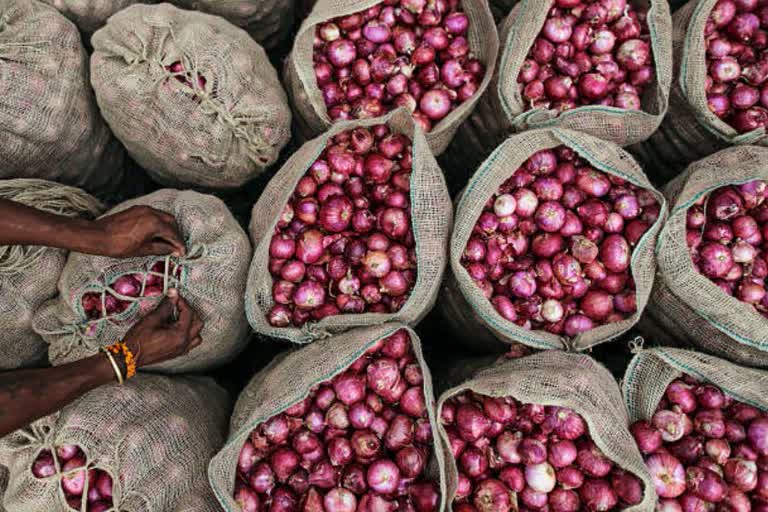Hyderabad: These days, all the kitchens across the country are still exploding with the ‘Onion Bombs’, even though it is almost a month after the Diwali festival in India. The nation is surprised to know how the price of the onion skyrocketed to a huge Rs.100/- per Kg price, and that too in the wholesale markets!!
In places like Solapur and Sanganer markets of Maharashtra are selling onions at a price of Rs. 110. In cities like Coimbatore of the southern part of India, big sized onion is being sold for Rs.100 while smaller ones are sold for Rs.130 per kg.
Even as the National Horticulture Board announced that the retail price of onion had risen to 80 rupees in several major cities across the country, the prices rocketed into the sky, overriding all the earlier prices. In cities like Hyderabad, Nagpur, Bhopal etc., on the other hand, onion prices have burned countless consumers' wallets.
In the states of Maharashtra, Karnataka, Madhya Pradesh, Gujarat, Rajasthan, UP and Bihar, the heavy and untimely rainfall has affected crop yields. India ranks 2nd after China in the international market of onion producers.
Union Minister Ramvilas Paswan stated that in three weeks onions will be imported from overseas, with the aim of improving yields and improving domestic supplies, after the unexpected heavy rains had hit the crop.
The responsibility to import and maintain the distribution of the produce has been entrusted to the commercial organization, MMTC and the distribution of the same shall be done before 15th December 2019 by the NAFED (National Federation of Agricultural Cooperative Marketing Federation of India) to all the states.
With the states demanding that the centre reduce the price of the subsidized onions, it is quite unclear as to the advantage that the consumers may get, at this turn of events.
It has been seen repeatedly where the consumers are becoming teary-eyed, thanks to the sudden high prices of the onions in our markets. Two years ago, the Center publicly admitted that it was unable to take quick corrective measures when the price of onion was above Rs 60.
Read more:Onion price reaches Rs 110/kg in wholesale market
Earlier this year, the Center assured that every state shall be granted the required amount of onion supply by end of September. However, most of the demand was not met with enough of supply, as promised. Within two months, the rate of onions increased at such a rate that it is quite impossible to believe that the Government has taken enough measures to tackle the situation.
The government has withdrawn its export subsidies, this time to the point that it has seen signs of danger. Retailers are allowed to store up to 100 quintals and wholesalers up to 500 quintals. Emergency imports from countries like Egypt have been decided upon. Various state governments have started selling onions on their own subsidized rates. However, such subsidies may not be of much use to the buyers. This kind of activity is only getting into loops.
Consumers are left wondering when prices will go down - farmers are worried about the cost of production just like when the rates of peanuts, tomato and potato in Gujarat, Himachal, Haryana and Punjab have been hanging in the air, irrespective of consumption. Almost every year, the plight of farmers or consumers of a crop has become a reality.
Governments are often reluctant to resort to mitigation when the problem is getting worse. We are a country with over fourteen billion hectares of agricultural land. When China is able to meet its own food requirements of up to 95 per cent of its land area - why should India import pulses and edible oil along with onions?
India can overcome decades of plight with allied crops. Specific information needs to be collected and codified by the panchayats wherever there are concessions for crop cultivation throughout the country. Government departments, agricultural research institutions should advise the farming community on the extent to which the varieties should be cultivated and how to reduce the local environment effects on the proposed crop - to ensure maximum yield achievement goals.
The government has to adopt the gross pricing mechanism so that the farmer does not suffer at any stage. Agreements must be made in advance to ensure that foreign imports become inevitable when conditions are not favourable for any crop. The export prospects abroad need to be thoroughly evaluated in terms of abundant yields for various crops.
In fact, such long-term planning and effective implementation are fundamental elements in the implementation of the mandate of the Ministry of Agriculture in the Center and the State. Governments' laziness over district-level crop planning, transport and storage facilities hypothesis ... is widening the gap between demand and supply, making the country dependent on external help.
Krishi Vignan Kendras, Agricultural Universities, and Government bodies should come forward to put to use the widespread technology with an integrated aim of improving the cultivation in the country. Under this scenario alone can we expect to disperse the dark clouds clouding the teary eyes of the onion consumer!!



